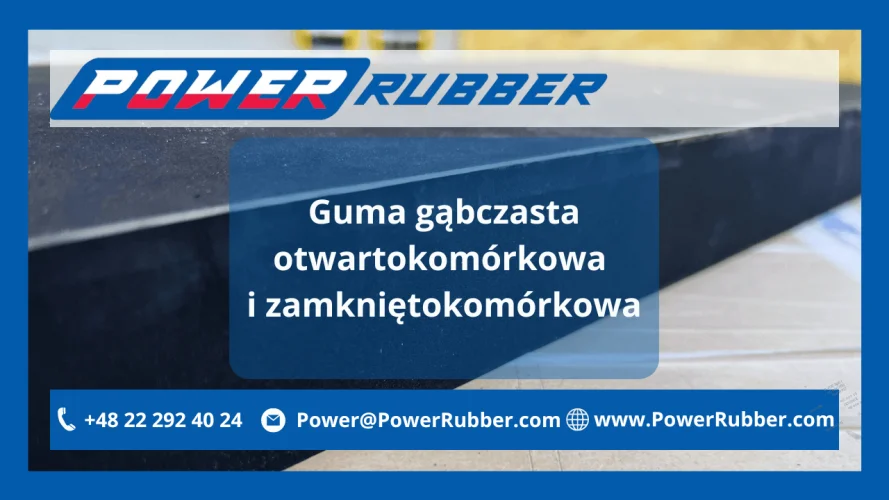Open-Cell and Closed-Cell Sponge Rubber: What’s the Difference?
What is sponge rubber?
Sponge rubber is a type of material with a porous cellular structure. It is made from various elastomeric and silicone compounds combined with chemical blowing agents, fillers and curing agents. The cellular structure gives it compressibility, flexibility and cushioning properties, making it ideal for sealing, vibration damping and insulation. Choosing the right material is crucial to ensure a long-lasting and reliable seal that does not degrade over time. The selection depends on its intended application, environmental conditions and performance requirements in specific operating conditions.
Benefits of using sponge rubber
Sponge rubber (also known as cellular rubber or foam rubber) is widely recognized for its excellent sealing properties. It offers superior compression and recovery, as well as shock absorption. Due to its high compressibility, it adapts to irregular shapes and surfaces, creating an airtight seal. Depending on the compound used, it withstands extreme temperatures in industrial conditions without losing performance. Its cellular structure provides outstanding sound and thermal insulation. Available in various densities and hardness levels (ShA).
What is sponge rubber used for?
Sponge rubber offers high resistance to compressive deformation. It maintains shape and functionality over time. High-quality foam rubber creates durable seals that minimise leakage risk and offers excellent insulation. It reduces heat transfer and acts as a sound barrier, making it ideal for acoustic insulation in buildings, vehicles and industrial machines. It is also widely used for cushioning, reducing vibrations and improving user comfort.
Common applications of cellular rubber
Thanks to its unique properties, sponge rubber is used across many industries: automotive, construction, electronics, aerospace, medical, marine, heavy equipment and public transport.
Where is sponge rubber used?
Sponge rubber provides sealing, cushioning and insulation. It prevents air and water infiltration, reduces noise, protects sensitive components and improves system durability. It is commonly used in:
-
automotive engines
-
wiring harnesses
-
window and door seals
-
electronic circuits
-
aircraft hatches
-
medical devices
-
hatches and enclosures
-
lift manufacturing
Types of sponge rubber
Cellular rubber contains tiny empty cells or voids, either interconnected or sealed. Therefore, it exists in two types: open-cell and closed-cell sponge rubber.
Open-Cell Sponge Rubber
Open-cell sponge rubber is made from a soft, breathable material that allows the flow of air, moisture and other substances. Its interconnected pockets resemble a sponge, allowing fluids to enter the material.
It offers elasticity and shape recovery without deformation. Its high compressibility helps it form a reliable seal around uneven surfaces. It’s ideal for applications that require moisture absorption or ventilation. Used in:
-
construction (weather resistance)
-
automotive (door/window seals, engine noise reduction)
-
electronics (shock absorption for devices)
-
HVAC (thermal insulation, condensation control)
-
transport
-
aerospace
-
expansion joints
-
everyday applications
Closed-Cell Sponge Rubber
Closed-cell sponge rubber is waterproof and highly buoyant. Its dense, non-interconnected cell structure blocks air, moisture and dust. Each cell is sealed like a balloon, preventing fluid and gas penetration.
It is valued for durability and shape retention. It performs better under compression than open-cell variants and maintains elasticity even at low temperatures. Ideal for environments requiring waterproofing or insulation. Used in:
-
automotive (antenna, HVAC and trunk seals)
-
appliances (dishwashers, refrigerators, lighting systems)
-
construction (window, door, and electrical box seals)
-
HVAC systems
-
electrical enclosures and control panels
-
marine industry (hatch seals)
-
aerospace (oil seals)
-
transport (conveyor belt cushions)
-
buoyancy aids
Open vs Closed Cell Sponge Rubber – Key Differences
Open-cell rubber:
-
Interconnected cell structure
-
Air and liquid permeability
-
High elasticity
-
Lower compression resistance
-
Ideal for sound insulation and vibration damping
Closed-cell rubber:
-
Sealed cells
-
Waterproof and airtight
-
Resistant to pressure and fluid penetration
-
Better shape recovery
-
Excellent thermal insulation and weather resistance
Where to buy sponge rubber?
At Power Rubber, we offer high-performance sponge rubber for industrial and manufacturing use. Our rubber delivers effective sealing, cushioning, shock absorption and thermal/acoustic insulation. Available in various hardness grades.
Contact us:
Phone: +48 22 292 40 24 or +48 505 16 03 03
Email: Power@PowerRubber.com
Contact form available on our website.
